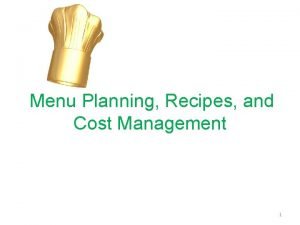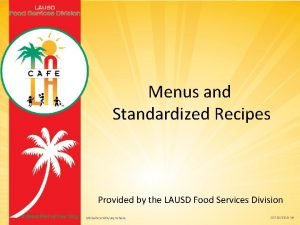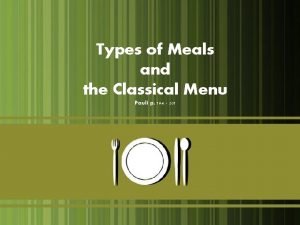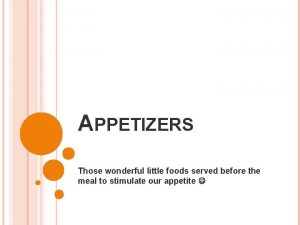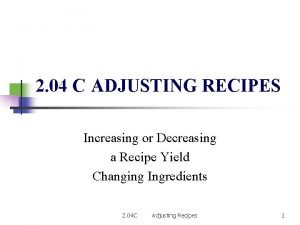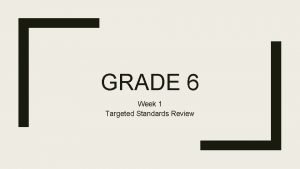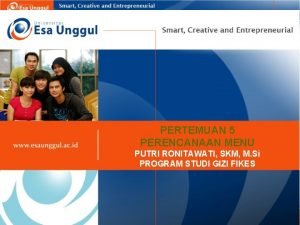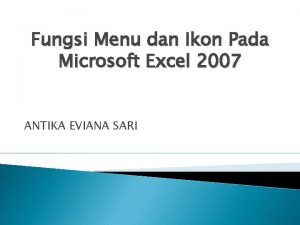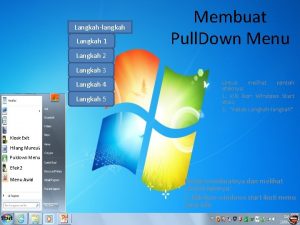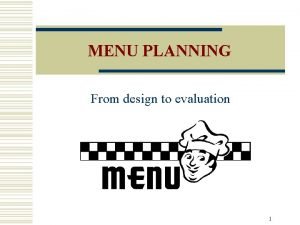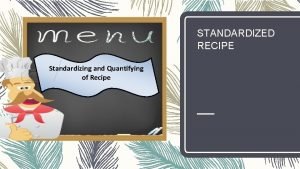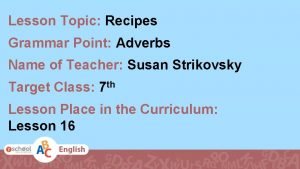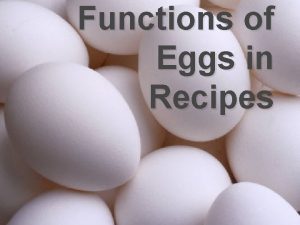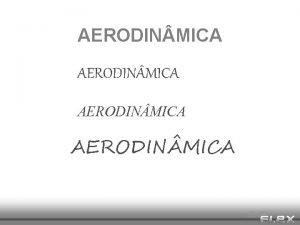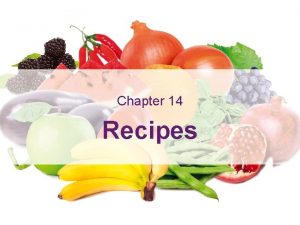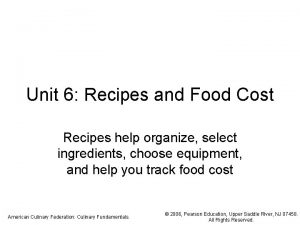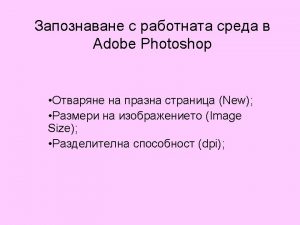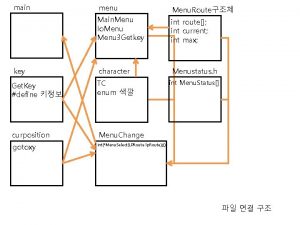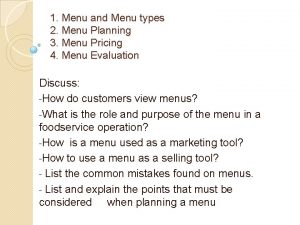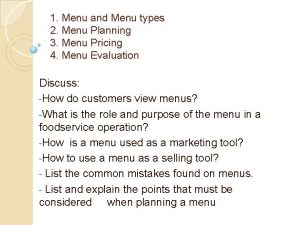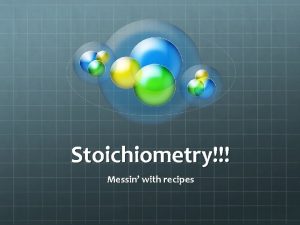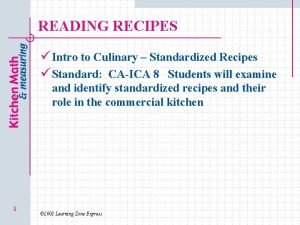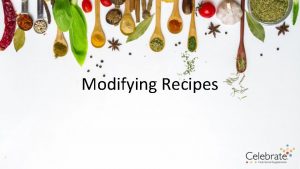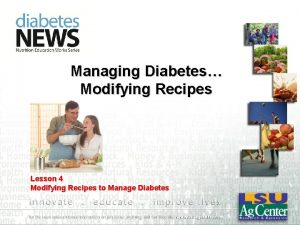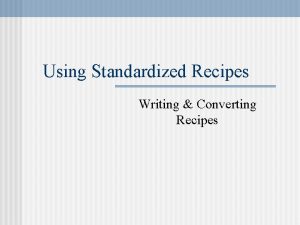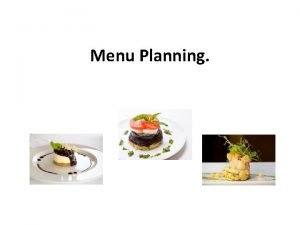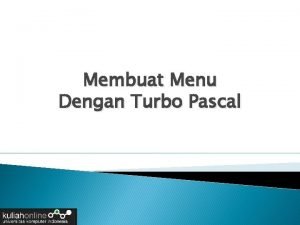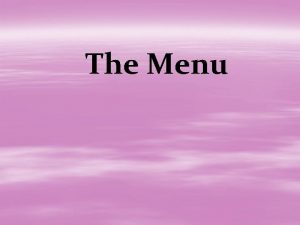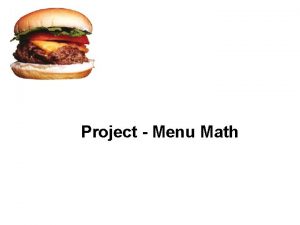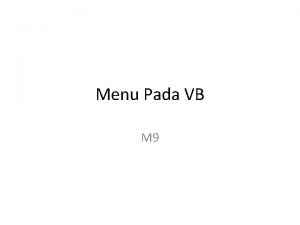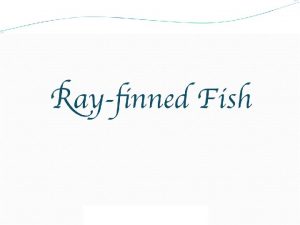Menu Planning Recipes and Cost Management 1 Unit






























- Slides: 30

Menu Planning, Recipes, and Cost Management 1

Unit Objectives • Describe different types of menus • Measure ingredients and portions • Discuss the structure and functions of standardized recipes • Convert recipes to higher or lower yields • Calculate raw food costs • Perform yield-cost analysis • Explain the principles of receiving, storage and inventory control 2

Menu Planning Components/ Considerations • Type of Institution (hotel, hospital, employee food service, catering, banquet, fast-food and take-out, fullservice restaurants) Can you think of others? 3

Menu Planning Components/ Considerations • Kind of Meal (breakfast, lunch, dinner, brunch) Again, can you think of others? 4

Types of Menus • • Static and Cycle menus À la carte and Table d’hôte Prix Fixe Tasting Menu 5

The Modern Menu • First Courses (appetizer, soup, fish, salad) • Main Dish (meat, poultry, fish with vegetable accompaniment) • Dessert Dishes (fruit and cheese, sweets) 6

Major Menu Planning Considerations Variety and Balance • • Flavors Textures Appearance Nutrients 7

Major Menu Planning Considerations, cont. • • Kitchen capacity Equipment limitations Availability of foods Personnel limitations 8

Major Menu Planning Considerations, cont. Food Item Concerns • • Point of origin Grade or quality Cooking method Size of portion 9

Terms Related to Menu Planning • “Fresh” • “Imported” • “Homemade” • “Organic” 10

Recipes • What is a “recipe? ” A recipe is a set of instructions for the production of a certain dish. • What type of information does a recipe provide? Some recipes supply extensive information and some very little, you always have to use judgment! 11

Recipes, cont. • What and why are you “judging? ” • Food products are not uniform • Kitchens have different equipment • It is really impossible for a recipe to provide instructions for all variables 12

Standardized Recipes • Menu development and recipe development are joint activities. • A standardized recipe should produce: – a known quality – a known quantity • A standardized recipe specifies: – Type and amount of each ingredient – Preparation and cooking procedures – Yields and portion size 13

Instructional Recipes vs. Standardized Recipes • The purpose of an instructional recipe is to teach the basics of cooking. • Instructional Recipes are structured differently than Standardized Recipes. • Instructional Recipes are more complete than Standardized Recipes. 14

Instructional Recipes Include: • Instructions for preparation – to help you learn and think about techniques • Variations and optional ingredients – to help you learn to see a pattern behind each recipe 15

Cooking with Judgment • When you use a recipe, apply your knowledge by asking yourself the following questions: – What basic cooking methods are being used? – What are the cooking times? – What are the characteristics of the ingredients? – What are the functions of the ingredients? 16

Measurement • Ingredient Measurement ü Volume - liquids ü Count ü Weight (most accurate) ü Even distribution ü Standard fill 17

Measurement, cont. • Portion Control – the measurement of portions to ensure that the correct amount of an item is served. ü Portion control begins with measuring ingredients. 18

The Metric System • The metric system is the most common measuring system in the world. • If a recipe is written using the metric system, use metric system measuring equipment. • If the recipe is written in the U. S. system, use the U. S. measurement equipment. 19

Metric System Measurement 1. 2. 3. 4. Volume - Liter Weight - Gram Length – Meter Temperature - Degree Celsius 20

Common Equivalents Dash = 1/8 tsp 3 tsp = 1 tbsp 2 tbsp = 1 fl. oz 4 tbsp = 1/4 cup (2 fl. oz) 5 1/3 tbsp = 1/3 cup (2 2/3 fl oz) • 16 tbsp = 1 cup • 2 cups = 1 pint (16 fl oz) • • • 2 pints = 1 quart (32 fl. oz) 4 quarts = 1 gallon (128 fl. oz) 2 Gallons = 1 peck 4 pecks = 1 bushel 1 fl. oz = 28. 35 grams 454 grams = 1 lb 2. 2 lbs = 1 kilogram (1000 grams) • 1 tsp = 5 milliliters • • 21

Framework for Judging Conversions A kilogram is about 2. 2 pounds A gram is about 1/30 ounce A pound is about 454 grams A liter is slightly more than a quart A centimeter is slightly less than ½ inch 0 degrees Celsius is the freezing point of water (32 degrees Fahrenheit) • 100 Celsius is the boiling point of water (212 degrees Fahrenheit) • • • 22

Problems with Converting Recipes • For the most part, conversion works well. • Very large conversions are a problem. • Consider the following: üMeasurement üSurface and volume üEquipment üTime 23

Additional Conversion Problems üEvaporation üRecipe Errors üLanguage Challenges 24

Food Cost • Factors to Consider: ü Menu ü Purchasing/ordering ü Receiving ü Storing ü Issuing ü Kitchen procedure (portion control and standards, waste, sales and service) 25

Controlling Food Costs • A critical part of the food service business is controlling costs. • The cost control system is a pathway to successful cost control and potential profits. 26

Food Cost Percentage • Always determined by the enterprises budget • See formula below: Percentage = food cost menu price 27

Yield Cost Analysis • Determines the difference between the AP (as purchased) price of an item and the EP (edible portion) of the item. ü As Purchased is the way an item is purchased untrimmed and un-fabricated. ü Edible Portion is the item that has been fabricated and all the unusable (for this recipe) parts taken away. 28

Purchasing Considerations • • Par stock Written specifications Price quotes Receiving Storing Measuring Serving 29

The Control System “A Well Planned Menu” • Use all edible trim. • Don’t add items unless you can use the trimmings. • Plan production to avoid leftovers. • Plan ahead for use of leftovers. • Avoid minimum-use ingredients. 30
 Menus recipes and cost management
Menus recipes and cost management Standardized recipes menu
Standardized recipes menu Standardized recipes menu
Standardized recipes menu Classical menu
Classical menu Characteristics of appetizer
Characteristics of appetizer Increasing and decreasing recipes
Increasing and decreasing recipes Chris and jenny are comparing two similar punch recipes
Chris and jenny are comparing two similar punch recipes Contoh pola menu
Contoh pola menu Fungsi menu excel
Fungsi menu excel Sebutkan menu-menu yang ada di mozilla firefox
Sebutkan menu-menu yang ada di mozilla firefox Langkah menu
Langkah menu Menu planning is an art. explain.
Menu planning is an art. explain. Cost accumulation and cost assignment
Cost accumulation and cost assignment Cost accumulation and cost assignment
Cost accumulation and cost assignment Cost accumulation and cost assignment
Cost accumulation and cost assignment Cost accumulation and cost assignment
Cost accumulation and cost assignment Dennis geyer
Dennis geyer Meaning of
Meaning of Distinguish between average cost and marginal cost
Distinguish between average cost and marginal cost Cost control and cost reduction difference
Cost control and cost reduction difference Job wr53 at nw fab
Job wr53 at nw fab Ordering cost and carrying cost
Ordering cost and carrying cost Trade off and opportunity cost
Trade off and opportunity cost Cost control and cost reduction project report
Cost control and cost reduction project report Cost control and cost reduction project report
Cost control and cost reduction project report The relative proportion of variable fixed or mixed
The relative proportion of variable fixed or mixed Cded diet phase 1
Cded diet phase 1 How to create a standardized recipe
How to create a standardized recipe Recipe modification
Recipe modification Adjective and adverb
Adjective and adverb Leavening agent egg example
Leavening agent egg example
